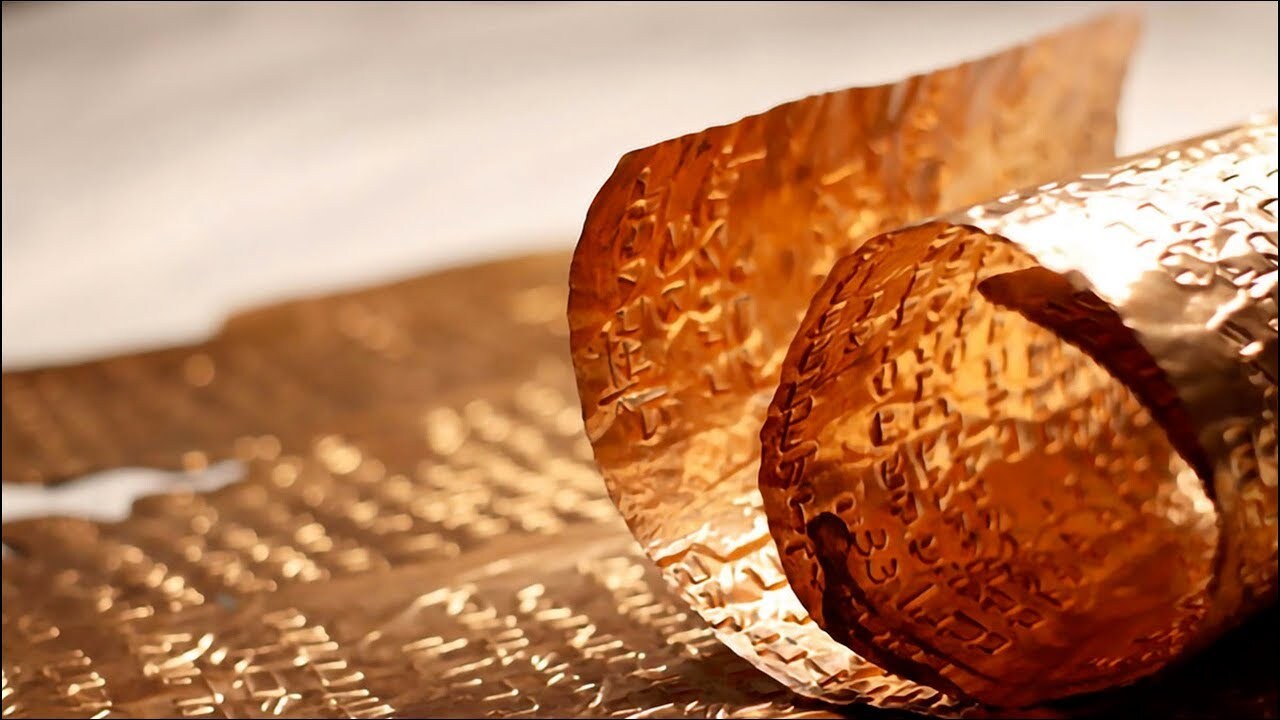
What is the Copper Scroll? Imagine stumbling upon an ancient treasure map, but instead of parchment, it's etched on copper. That's the Copper Scroll for you! Found in 1952 in Cave 3 at Qumran, this unique artifact lists 64 locations of hidden treasures, including gold, silver, and religious artifacts. Unlike other Dead Sea Scrolls, it's made of copper mixed with tin, making it both a marvel and a mystery. Scholars date it between 25 AD and 100 AD, but its exact origins and the fate of its treasures remain subjects of debate. Ready to dive into its secrets? Let's go!
Key Takeaways:
- The Copper Scroll, a unique artifact from the Dead Sea Scrolls, holds the mystery of hidden treasures worth over a billion dollars, captivating the public with its Indiana Jones-like allure.
- Despite controversy and skepticism, ongoing research on the Copper Scroll continues to unravel its secrets, shedding light on its historical significance and biblical importance.
25 Facts About The Copper Scroll
Discovery and Location
The Copper Scroll, one of the most intriguing artifacts from the Dead Sea Scrolls, has a unique story of discovery and location.
- The Copper Scroll was discovered on March 14, 1952, at the back of Cave 3 at Qumran, near Khirbet Qumran on the shores of the Dead Sea.
Unique Material
Unlike other scrolls, the Copper Scroll stands out due to its unusual material.
- Unlike other Dead Sea Scrolls, which are made of parchment or papyrus, the Copper Scroll is inscribed on copper mixed with about 1 percent tin.
Condition at Discovery
The state of the Copper Scroll when found posed significant challenges for researchers.
- The corroded metal made it impossible to unroll the scroll by conventional means. It was later cut into 23 strips and pieced back together.
Historical Context
Understanding the timeframe of the Copper Scroll helps place it within a broader historical narrative.
- The Copper Scroll is dated to between 25 AD and 100 AD, placing it in the Herodian period. This timeframe suggests that it may not be directly related to the Jewish Temple treasures.
Authorship and Purpose
The origins and intentions behind the Copper Scroll remain a mystery.
- The authorship of the Copper Scroll remains a mystery. Some scholars believe it was not an official work of the Essenes, who lived in Qumran, but rather a separate document placed in the cave at a different time.
Content Structure
The Copper Scroll's content is organized in a specific and detailed manner.
- The text of the Copper Scroll is an inventory of 64 locations, each detailing the hiding places of vast treasures of gold and silver. The structure of each entry includes a general location, specific location with distance to dig, and what to find.
Treasure Locations
The scroll lists numerous locations where treasures are supposedly hidden.
- The scroll lists 63 locations of treasures, including gold and silver, tithing vessels, and even priestly vestments. One entry mentions scrolls, and another points to a duplicate document with additional details.
Estimated Value
The treasures mentioned in the Copper Scroll are of immense value.
- The total treasure listed on the Copper Scroll is estimated to be over 4,600 talents of precious metal. This translates to approximately 58 to 174 tons of gold and silver, valued at over a billion dollars in today's currency.
Specific Examples of Treasure
Some entries in the scroll provide detailed descriptions of the treasures.
- One location describes 900 talents (868,000 troy ounces) of buried gold. Another entry mentions 41 talents of silver in the salt pit under the steps.
Historical Significance
The origins of the treasures listed in the Copper Scroll are debated among scholars.
- The treasure listed on the Copper Scroll has been assumed to be from the Jewish Temple, but its exact origin remains a topic of debate. Some scholars believe it could be related to the First Temple, while others suggest it might be from the Second Temple.
Cave of Letters Connection
There is a theory connecting the Copper Scroll to another significant archaeological site.
- There is a minority view that the Cave of Letters might have contained one of the listed treasures. If so, artifacts from this location may have been recovered, but this theory is not widely accepted.
Scholarly Interpretations
Different scholars have varying opinions on the Copper Scroll's contents.
- Scholars have taken various approaches to interpreting the Copper Scroll. Some believe the treasure is imaginary, while others see it as evidence of hidden treasures that the Romans could not find.
Milik’s Edition
One of the first official editions of the Copper Scroll was published by a notable scholar.
- Józef Milik published the first official edition of the Copper Scroll in 1962. His transcription remains the most widely used version today.
Allegro’s Edition
Another early edition of the scroll was published by a controversial figure.
- John Marco Allegro published his own edition of the scroll before Milik’s official version. Allegro was excited about the prospect of a treasure hunt, which led to some controversy.
Copper Scroll Project
A modern initiative aims to uncover the treasures listed in the scroll.
- The Copper Scroll Project aims to help Israel recover the items listed on the scroll. The project has conducted extensive research and mapping of the treasure locations, which has garnered significant attention and support.
Investigative Techniques
The project employs various methods to verify the scroll's claims.
- The project uses investigative techniques to verify the locations listed on the scroll. This includes mapping, photography, and field research to confirm the existence of these hidden treasures.
Public Interest
The Copper Scroll has captured the imagination of many.
- The Copper Scroll has captured the imagination of the public, inspiring books, movies, and documentaries. Its allure lies in the Indiana Jones-like adventure it promises, with tales of hidden treasures and ancient mysteries.
Religious Significance
The treasures listed in the scroll hold significant religious importance.
- The treasures listed on the Copper Scroll are believed to include significant religious artifacts. These items are thought to be crucial for Levitical priests and their families, who are trained to handle and care for them according to biblical requirements.
Biblical Requirements
Handling the artifacts requires adherence to specific religious guidelines.
- The project emphasizes the importance of complying with biblical requirements when handling the artifacts. This includes ensuring that only authorized individuals, such as Levitical priests, are involved in the recovery and care of these relics.
International Recognition
The Copper Scroll Project has gained attention from various media outlets.
- The Copper Scroll Project has received positive reviews from various international media outlets, including The Travel Channel, television news stations, Israel National Radio, and The Jerusalem Post.
Archaeological Excavations
Excavations have been conducted at some of the locations listed in the scroll.
- An Israeli archaeologist from the Archaeological Department of the Civil Administration initiated an excavation at three of the locations listed on the scroll. However, the excavation stopped short of the required depth, leaving the treasures potentially undiscovered.
Controversy and Criticism
The project has faced its share of skepticism.
- The project has faced criticism from some scholars who question its methodology and conclusions. However, the project's supporters argue that their research is thorough and based on extensive fieldwork and documentation.
Cultural Impact
The Copper Scroll has influenced popular culture.
- The Copper Scroll has become a cultural phenomenon, inspiring numerous books and films. Its story has captivated audiences worldwide with tales of hidden treasures and ancient mysteries.
Historical Records
Historical accounts provide context for the treasures mentioned in the scroll.
- Historical records suggest that the main treasure of the Jewish Temple was still in the building when it fell to the Romans. However, it does not rule out the possibility that a significant portion of the treasures may have been taken away and hidden before the Romans arrived.
Ongoing Research
Research on the Copper Scroll continues to this day.
- Despite the challenges and controversies surrounding the Copper Scroll, ongoing research continues to uncover new insights into its contents and historical context. Scholars remain fascinated by this enigmatic artifact, seeking to unravel its secrets and understand its significance in biblical history.
The Enigma of the Copper Scroll
The Copper Scroll stands out as a unique artifact among the Dead Sea Scrolls. Its copper material, detailed inventory of hidden treasures, and mysterious origins have fascinated scholars and treasure hunters alike. Discovered in 1952 in Cave 3 at Qumran, this scroll lists 64 locations with vast amounts of gold and silver. Despite extensive research and even some excavations, the treasures remain undiscovered, adding to the scroll's allure. Theories about its origins range from connections to the Jewish Temple to being a separate document placed in the cave later. Ongoing research and projects like the Copper Scroll Project continue to explore its secrets, keeping the mystery alive. Whether the treasures are real or symbolic, the Copper Scroll remains a captivating piece of history, blending archaeology, religion, and adventure in a way few artifacts can.
Frequently Asked Questions
Was this page helpful?
Our commitment to delivering trustworthy and engaging content is at the heart of what we do. Each fact on our site is contributed by real users like you, bringing a wealth of diverse insights and information. To ensure the highest standards of accuracy and reliability, our dedicated editors meticulously review each submission. This process guarantees that the facts we share are not only fascinating but also credible. Trust in our commitment to quality and authenticity as you explore and learn with us.


